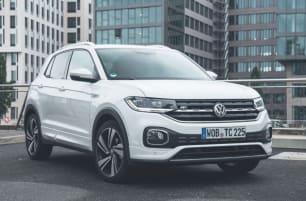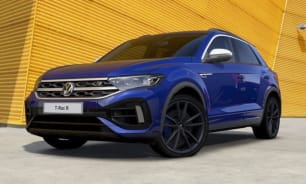With a starting price of $27,990 MSRP (before on-road costs), the VW T-Cross is priced close to a number of key competitors in the small SUV segment.
It’s up against the likes of the Honda HR-V (from $24,990, VTi auto) Mitsubishi ASX (from $25,990, ES auto), Nissan Qashqai (from $29,990, ST auto), so if brand cache is what you’re after in your small SUV, this compact semi-premium branded model is going to appeal.
It also has plenty of boast about when it comes to standard specs, with a comprehensive equipment list offered on all models.
Starting at the base model 85TSI Life, the list includes 16-inch alloy wheels, halogen headlights with LED daytime running lights, manual air-conditioning, wireless smartphone charger (Qi), four USB ports (2x front, 2x rear), black roof rails, a leather multi-function steering wheel, front fog-lights, automatic headlights and 8.0-inch multimedia system with app-connect functionality (Apple CarPlay and Android Auto phone mirroring), as well as Bluetooth connectivity.
The safety spec list is decent, as well. All T-Cross models come with a reversing camera, autonomous emergency braking with pedestrian and cyclist detection, driver fatigue detection, parking sensors and low-pressure tyre indicator.
If you step up the budget a bit to the T-Cross 85TSI Style ($30,990 MSRP), you see the addition of 17-inch wheels, LED headlights, dual-zone climate control, keyless entry, push-button start, steering wheel-mounted paddle shifters, front sports seats and chrome exterior highlights.
The list price of the 110TSI Style model is yet to be determined (we’re expecting about $36K). But as well as a bigger engine, it’ll add some extra gear, such as 18-inch alloy wheels, dark tinted rear windows, gloss black door mirrors and model-specific interior trim finishes.
The Style grade additionally gains safety items such as adaptive cruise control, blind-spot monitoring, automatic high beams and rear cross-traffic alert. That gear can be added to the Life model for $1200.
There are two other packs available, both of which are fitted to the model you see in these pictures.
The ‘Sound and Vision’ pack ($1900) is available on all grades, and sees the addition of the brand’s excellent digital cockpit, plus onboard GPS sat nav, and a 300-watt premium sound system by Beats.
The ‘R-Line’ package (only on Style grades - $2500 for the 85TSI and $1900 for the 110TSI) upsizes the rims to 18-inches, plus adds gloss black body accents, aluminium pedals, a flat-bottom steering wheel, tinted rear windows, unique cloth upholstery, dark headlining and R-Line door scuff plates.
Curious about colours (or colors, depending on where you’re reading this)? There are a few to choose from, including: Pure White and Dark Petrol (dark blue) at no cost, then there are the metallic finishes ($600) including Energetic Orange, Limestone Grey, Reflex Silver and Reef Blue, and then there’s this “special colour”, Makena Turquoise Metallic ($800).
Curious about T-Cross accessories? There are several to choose from, including load sill protection plates, door sill protectors, tailgate garnish, roof rack bars, a roof cargo box, a bicycle carrier, ski/snowboard carrier, mudflaps, side steps, floor mats (rubber), cargo mat, cargo tray, weathershields and different rims.















































 copy.png)










